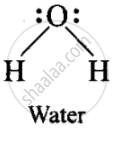Advertisements
Advertisements
Question
In both water and dimethyl ether \[\ce{(CH3 - \overset{\bullet\bullet}{\underset{\bullet\bullet}{O}} - CH3)}\], oxygen atom is central atom, and has the same hybridisation, yet they have different bond angles. Which one has greater bond angle? Give reason.
Solution
Dimethyl ether has larger bond angle than water. This is because there is more repulsion between bond pairs of \[\ce{CH3}\] groups attached in ether than between bond pairs of hydrogen atoms attached to oxygen in water. The carbon of \[\ce{CH3}\] group in ether is attached to three hydrogen atoms through c bonds and electron pairs of these bonds add to the electron charge density on carbon atom. Hence, repulsion between two \[\ce{^-CH3}\] groups will be more than that between two H atoms.


APPEARS IN
RELATED QUESTIONS
Assertion (A): Though the central atom of both \[\ce{NH3}\] and \[\ce{H2O}\] molecules are sp3 hybridised, yet \[\ce{H -N - H}\] bond angle is greater than that of \[\ce{H - O - H}\].
Reason (R): This is because nitrogen atom has one lone pair and oxygen atom has two lone pairs.
Which of the following species has bond angle less than 98°?
Which one of the following compounds has the smallest bond angle in its molecule?
